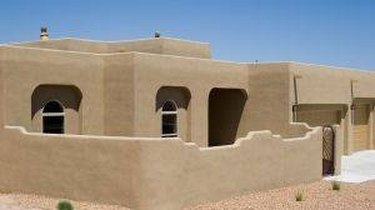
Exterior Moisture
Moisture is the enemy of stucco, and elements such as snow, freezing rain and ice can quickly damage stucco. From the outside, snow, rain and melting ice are absorbed into the stucco, causing it to swell and bulge. It can also cause the stucco to separate from the wall, creating a pocket inside the wall where moisture can become trapped and do additional damage. Once moisture has soaked into or penetrated the stucco, shifting temperatures do additional damage, causing the stucco to crack as the water it retains shrinks and expands with the weather.
Interior Moisture
Video of the Day
Moisture trapped between the stucco and the wall can cause large bubble to appear in the stucco. Eventually these bubbles will either become so large that they burst open and the stucco falls off the wall, or they last through the winter season only to dry and shrink, cracking as they shrink. The trapped moisture, if it stays long enough, can also create an atmosphere where mold will grow between the wall and the stucco. This is especially common when winter temperatures warm up quickly after a snow or rain storm.
Video of the Day
Cold, Dry Weather
Stucco can fare well in winter climates if they are dry but cold climates. The shifts in temperature will cause the stucco to swell and shrink, but not more so than other materials like wood and metal. As long as the stucco is not penetrated by moisture, the shrinking and expansion will not cause damage and the stucco will not be harmed by the cold weather. Stucco also fares well in cold and windy climates when there is not too much moisture.